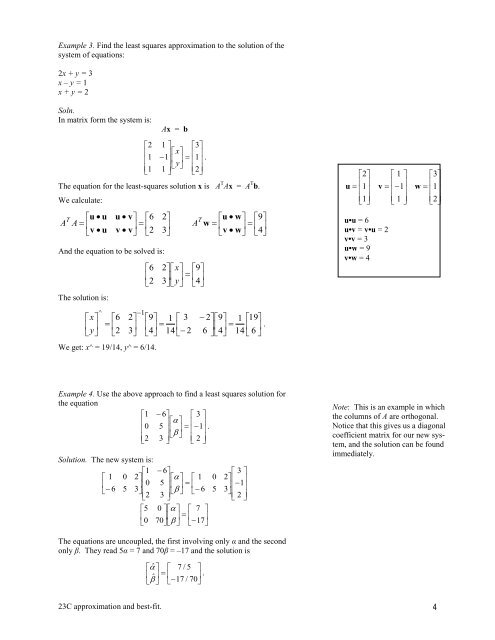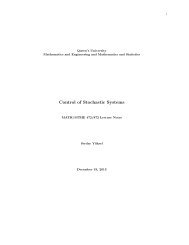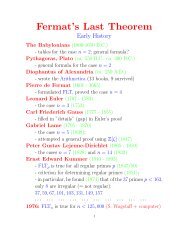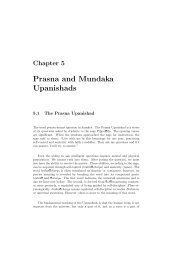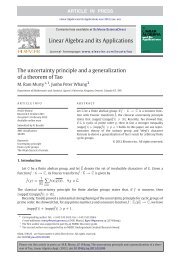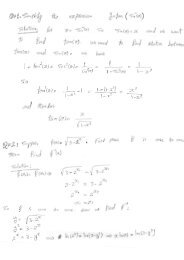For example what is the matrix of the linear transformation from R3 ...
For example what is the matrix of the linear transformation from R3 ...
For example what is the matrix of the linear transformation from R3 ...
You also want an ePaper? Increase the reach of your titles
YUMPU automatically turns print PDFs into web optimized ePapers that Google loves.
Example 3. Find <strong>the</strong> least squares approximation to <strong>the</strong> solution <strong>of</strong> <strong>the</strong><br />
system <strong>of</strong> equations:<br />
2x + y = 3<br />
x – y = 1<br />
x + y = 2<br />
Soln.<br />
In <strong>matrix</strong> form <strong>the</strong> system <strong>is</strong>:<br />
2<br />
<br />
<br />
1<br />
<br />
1<br />
Ax = b<br />
1 3<br />
<br />
x<br />
1<br />
<br />
<br />
<br />
<br />
1<br />
<br />
.<br />
<br />
y<br />
1<br />
<br />
<br />
2<br />
The equation for <strong>the</strong> least-squares solution x <strong>is</strong> A T Ax = A T b.<br />
We calculate:<br />
A T<br />
u<br />
u<br />
A <br />
v<br />
u<br />
u v<br />
6<br />
<br />
v v<br />
<br />
2<br />
And <strong>the</strong> equation to be solved <strong>is</strong>:<br />
The solution <strong>is</strong>:<br />
^<br />
x<br />
6<br />
<br />
y<br />
2<br />
6<br />
<br />
2<br />
1<br />
2<br />
9<br />
<br />
3<br />
4<br />
We get: x^ = 19/14, y^ = 6/14.<br />
2<br />
3<br />
<br />
<br />
T<br />
A w<br />
2<br />
x<br />
9<br />
<br />
3<br />
<br />
<br />
y<br />
4<br />
1 3<br />
14<br />
<br />
<br />
2<br />
u<br />
w<br />
9<br />
<br />
4<br />
<br />
v<br />
w<br />
<br />
29<br />
<br />
<br />
6 4<br />
1 19<br />
.<br />
14 6 <br />
Example 4. Use <strong>the</strong> above approach to find a least squares solution for<br />
<strong>the</strong> equation<br />
1 6<br />
3 <br />
<br />
<br />
<br />
<br />
<br />
0 5<br />
<br />
<br />
1<br />
<br />
.<br />
<br />
<br />
2<br />
3 <br />
2 <br />
Solution. The new system <strong>is</strong>:<br />
1<br />
<br />
<br />
6<br />
0<br />
5<br />
1 2<br />
<br />
0<br />
3<br />
2<br />
6<br />
<br />
1<br />
5<br />
<br />
<br />
<br />
<br />
6<br />
3 <br />
0<br />
5<br />
5<br />
<br />
0<br />
0 <br />
7 <br />
<br />
<br />
70<br />
<br />
<br />
17<br />
3 <br />
2<br />
<br />
<br />
1<br />
3 <br />
<br />
2 <br />
The equations are uncoupled, <strong>the</strong> first involving only α and <strong>the</strong> second<br />
only β. They read 5α = 7 and 70β = –17 and <strong>the</strong> solution <strong>is</strong><br />
ˆ 7 / 5 <br />
ˆ<br />
.<br />
<br />
17<br />
/ 70<br />
2<br />
u <br />
<br />
<br />
1<br />
<br />
<br />
1<br />
u•u = 6<br />
u•v = v•u = 2<br />
v•v = 3<br />
u•w = 9<br />
v•w = 4<br />
1 <br />
v <br />
<br />
<br />
1<br />
<br />
<br />
1 <br />
3<br />
w <br />
<br />
<br />
1<br />
<br />
<br />
2<br />
Note: Th<strong>is</strong> <strong>is</strong> an <strong>example</strong> in which<br />
<strong>the</strong> columns <strong>of</strong> A are orthogonal.<br />
Notice that th<strong>is</strong> gives us a diagonal<br />
coefficient <strong>matrix</strong> for our new system,<br />
and <strong>the</strong> solution can be found<br />
immediately.<br />
23C approximation and best-fit. 4


